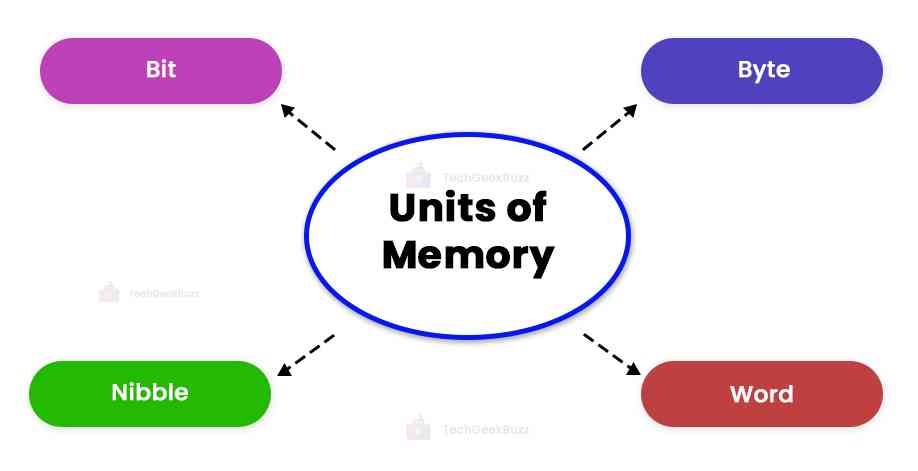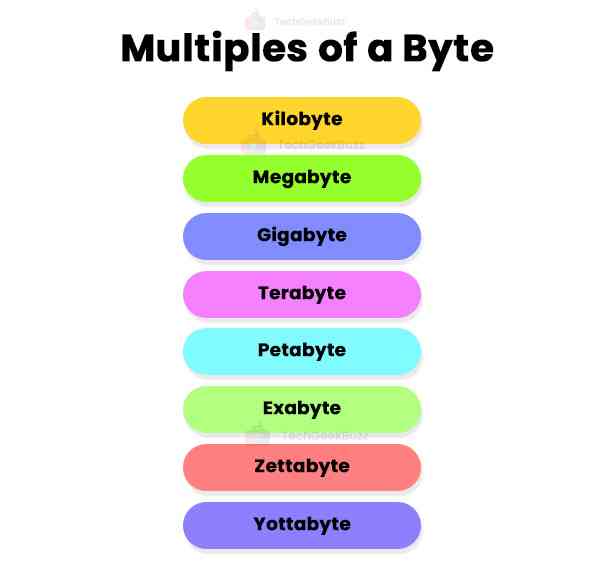If you work with different files on a computer system, you may notice that each file has a different size, such as KB, MB, GB, etc. These are nothing but memory units. Continue reading this article to learn in detail about memory units in a computer system.
Memory, or computer memory, is a space in computer systems to store data/information and instructions permanently or temporarily. It processes data and stores instructions required to process data.
A memory that stores information temporarily or for a short time is volatile memory . It loses the stored data and instructions when a computer system or hardware switches off. RAM (Random Access Memory) is an example of this.
Conversely, a memory that stores information permanently and does not lose the stored data even after a computer system switches off is non-volatile memory . EPROM (Erasable Programmable ROM) is an example of this.
With the increasing usage and demand for computer systems, computer memory has evolved over the past decades. Every new memory version is faster and of higher capacity than its previous one. This, in turn, resulted in new units or sizes of memory.
So, if you are new to using a computer system, knowing the different units of memory is essential. Let us discuss them in this article.
What is a Memory Unit?
A memory unit is the amount of memory or storage used to represent or measure data. It stores digital data that can be read, written, and accessed. In other words, it makes the storage and retrieval of data possible.
Basic Units of Memory in Computer Systems
The following are the basic units of memory in computer systems –

1. Bit
Computer systems generally comprise integrated circuits, semiconductors, and other electrical components. These components understand binary data , i.e., data in the form of 0s and 1s, where 0 indicates the OFF state and 1 indicates ON.
These two states, 0 and 1, are called bits or binary digits. Hence, computer systems store and process data in the form of binary digits.
A bit is represented as ‘b’. Here, 1 signifies the presence of the signal, and 0 represents the absence of the signal.
It is important to note that a single bit can either store 0 or 1 at a time. As a result, it is the smallest unit of data. When you combine multiple bits, it forms a unit that can store a greater range of values.
2. Nibble
Also referred to as nybble or nyble, a nibble is a memory unit that combines 4 bits or binary digits. In other words, it is half of a byte (We will discuss it in the following section). Hence, it is called a half-byte or tetrade.
A nibble is capable of holding 24 = 16 possible values. You can represent it by a hexadecimal digit having a base of 16.
|
Decimal |
Nibble |
|
0 |
0000 |
|
1 |
0001 |
|
2 |
0010 |
|
3 |
0011 |
|
4 |
0100 |
|
5 |
0101 |
|
6 |
0110 |
|
7 |
0111 |
|
8 |
1000 |
|
9 |
1001 |
|
10 |
1010 |
|
11 |
1011 |
|
12 |
1100 |
|
13 |
1101 |
|
14 |
1110 |
|
15 |
1111 |
3. Byte
A byte is a collection or string of 8 bits representing a single letter, number, or typography symbol . Originally, the byte was the number of bits used to encode a single character of a text in computer systems.
Moreover, many computer architectures consider the byte the fundamental or smallest unit. It is also represented in larger multiples, such as kilobyte, megabyte, gigabyte, terabyte, etc.
|
Multiple of Bytes |
Abbreviation |
Binary Representation for a Byte |
Decimal Representation for a Byte |
|
Kilobyte |
KB |
1024 (210) bytes |
1,000 (103) bytes |
|
Megabyte |
MB |
1,048,576 (220) bytes |
1,000,000 (106) bytes |
|
Gigabyte |
GB |
1,073,741,824 (230) bytes |
1,000,000,000 (109) bytes |
|
Terabyte |
TB |
1,099,511,627,776 (240) bytes |
1,000,000,000,000 (1012) bytes |
|
Petabyte |
PB |
1,125,899,906,842,624 (250) bytes |
1,000,000,000,000,000 (1015) bytes |
|
Exabyte |
EB |
1,152,921,504,606,846,976 (260) bytes |
1,000,000,000,000,000 (1018) bytes |
|
Zettabyte |
ZB |
1,180,591,620,717,411,303,424 (270) bytes |
1021 bytes |
|
Yottabyte |
YB |
1,208,925,819,614,629,174,706,176 (280) bytes |
1024 bytes |
Let us discuss these larger multiples of a byte in detail below.

-
Kilobyte
A kilobyte is the smallest multiple of a byte. It is often abbreviated as KB . The prefix ‘kilo’ is a decimal unit prefix in the metric system that represents the multiplication by thousand ( 1000 or 10 3 ). However, the data is stored in binary form in computer systems, i.e., as a base of 2. Hence, here a ‘kilo’ refers to 1024 bytes containing binary bits.
This unit of memory is generally used to measure the size of text documents, individual files, and website graphics.
Check out: Program to Convert Decimal to Binary
-
Megabyte
The next multiple of a byte is a megabyte, abbreviated as MB . In the International System of Units (SI), ‘mega’ represents 1,000,000, i.e., ( 10 6 ), as it follows the decimal system. In the context of the binary system, 1 megabyte or 1 MB consists of 1,048,576 ( 2 20 ) bytes.
A megabyte generally measures a large size of files, such as songs, images, compact disks, etc.
-
Gigabyte
A larger multiple of a byte than MB is a gigabyte, often denoted as GB . According to SI, a gigabyte corresponds to 1000,000,000 ( 10 9 ) bytes. As per the binary representation, a gigabyte or GB equals 1,073,741,824 ( 2 30 ) bytes.
This memory unit is generally used to measure the capacity of a storage device .
-
Terabyte
The prefix ‘tera’ in a terabyte, or TB , represents 1,000,000,000,000 ( 10 12 ) bytes in the decimal number system. The binary representation of a terabyte is 2 40 bytes, which is equal to 1,099,511,627,776 bytes .
Generally, a terabyte is a unit of memory used to measure the storage capacity of devices like hard disk drives (HDDs).
-
Petabyte
Often abbreviated as PB , a petabyte contains 1,000,000,000,000,000 ( 10 15 ) bytes in the decimal number system. However, in a binary number system, a petabyte equals 1,125,899,906,842,624 ( 2 50 ) bytes.
A petabyte is usually used to measure the data storage in large networks or servers, such as the data servers of Google and Facebook.
-
Exabyte
A larger multiple of a byte than a petabyte is an exabyte, whose acronym is EB . The prefix exa corresponds to 1,000,000,000,000,000,000 ( 10 18 ) bytes in the decimal representation. In terms of binary representation, an exabyte is equal to 1,152,921,504,606,846,976 ( 2 60 ) bytes.
An exabyte is a very large memory unit used to measure the amount of data transferred over the Internet for a specific timeframe.
-
Zettabyte
Often abbreviated ZB, the decimal representation of a zettabyte is 1,000,000,000,000,000,000,000, i.e., 10 21 bytes. We denote a zettabyte as 1,180,591,620,717,411,303,424 ( 2 70 ) bytes in the form of Base 2.
The zettabyte memory unit can be used to measure the amount of data present worldwide.
-
Yottabyte
This unit of memory has no practical application, as it is the largest multiple of a byte. Abbreviated as YB, a yottabyte contains 10 24 bytes in the decimal number system and 1,208,925,819,614,629,174,706,176 ( 2 80 ) bytes in the binary number system.
4. Word
A word is analogous to a byte, as it is also a sequence of bits. However, each computer architecture has a predefined, fixed number of bits to form a word. This means the number of bits in a word varies from one computer system to another.
The number of bits in a word can be as few as 8 bits and as many as 96 bits.
Generally, the defined number of bits is equal to a computer’s data bus. This makes it possible for a word to move from the storage to the processor’s register in a single operation.
If a computer system’s architecture is an 8-bit byte, the word size is the multiple of 8 bits. In IBM's System/360 mainframe architecture, a word is 16 bits, i.e., 4 contagious 8-bit bytes. Conversely, Intel’s PC processor architecture uses a word as 16 bits, i.e., 2 contagious 8-bit bytes.
Conclusion
This was all about the units of memory in computer systems. A memory unit represents the storage capacity of memory. A bit, nibble, byte, and word are fundamental memory units. However, a byte is primarily used to express the storage capacity of memory. As discussed above, it has several multiple, such as KB, MB, GB, TB, PB, EB, ZB, and YB.
If you have any queries regarding this article, please comment below.
People are also reading:


![What is an Assembler? [Definition, Working, & Types]](/media/new_post_images/What_is_Assembler.jpg)
![What is I/O? [Types, Examples, & Methods]](/media/new_post_images/What_is_I_O.webp)

Leave a Comment on this Post